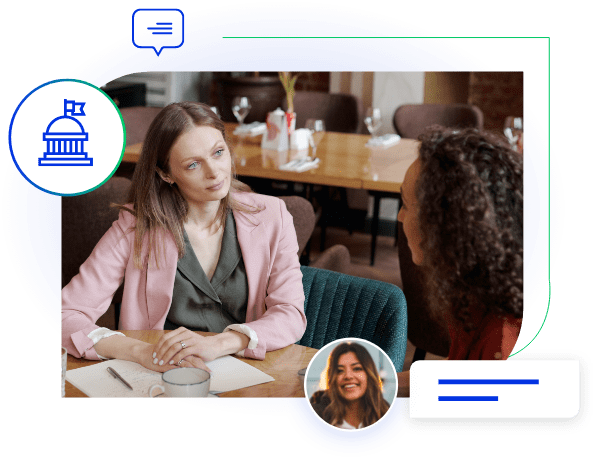One of the driving forces for workers in the public sector is the desire to make a difference. While the work isn’t always glamorous, knowing that your work has made a positive impact on the public can be incredibly rewarding.
As much as public sector workers remain dedicated to their work, red tape can still erode the goodwill of the public. In a survey conducted by McKinsey & Company comparing customer experience (CX) in the public and private sectors, private companies came out far ahead. In this article, we’ll look at these public sector customer experience findings in more detail and explore how these takeaways can help government agencies improve public engagement, trust and CX.
1. Citizens are 9x more likely to trust a government agency when they are satisfied with the service they receive
Perhaps more than any other, the topic of trust makes a strong case for public sector customer experience. When government customers are satisfied with the service they receive, they’re on average nine times more likely to trust a government agency. The balance of this trust is even higher in some agencies, with McKinsey reporting:
“…for Immigration, Refugees, and Citizenship Canada, a department of the Canadian government, citizens are 26 times more likely to trust the agency when they’re satisfied.”
With government customers also being taxpayers, there’s an inherent need to strike a balance between service delivery and efficiency. When your customers are also stakeholders, you want to demonstrate the value of their investment. Seeing the failure of a service can be demoralizing to government employees.
Thankfully, with room for growth comes opportunity. McKinsey also highlights the power of organizational transformation in government:
“An effort undertaken by the US Department of Veterans Affairs focused on transforming veterans’ experiences with the agency increased trust from 47 percent in 2015 to 70 percent just three years later.”
Read more: How to Improve Service Delivery in Public Sector & Government – 4 Foundational Steps
2. Dissatisfied citizens are twice as likely to reach out for support 3 or more times
Service delivered poorly comes with inefficiencies that aren’t always apparent. In public sector customer experience, a poor use of resources can mean wasted tax dollars and less support available for citizens. McKinsey’s research shows why unhappy government customers can create a burden for agency hotlines:
“… dissatisfied citizens are twice as likely to contact agency hotlines three or more times for help.”
Improving customer service in government is no easy feat, so this stat shouldn’t be taken lightly. Unlike the private sector, many government services are not designed to bring funds into the organization. While private companies with a steady income stream might be able to overcome an issue by “throwing money at it,” this isn’t an option in the public sector where resources are often fixed.
In situations where an organization always seems to need more resources, the answer can come as a changed approach. McKinsey found one public sector organization that improved communications to boost customer satisfaction:
“Originally, in its customer communications, it noted that the average time to distribute refunds was two days. When the agency changed its communications to say that refunds were distributed in 21 days—which reflects a response time in the 90th percentile—there was no meaningful change to service execution, but customers were happier and inbound calls were reduced dramatically.”
Transform Public Sector Customer Experience with Digital Solutions
Empower your government agency to bridge the gap between public and private sector customer experience. Discover how digital tools like live chat and chatbots can enhance public engagement, build trust, and improve service delivery.
Learn more
Solution
3. Dissatisfied citizens are twice as likely to publicly express their unhappiness.
We’ve already looked at the importance of trust in the government-citizen relationship. In today’s world of social media, a significant portion of that trust comes from other members of the public. As customers interact with government organizations, maintaining the image of public services becomes key for government strategy. McKinsey’s research found that public sector CX is once again at the core of the issue:
“We found that dissatisfied customers are twice as likely to publicly express their unhappiness through social media, letters, hotlines, or calls to local politicians.”
While an impartial government worker may not have a stake in the public perception of their officials, the programs they support are another matter. Poor perception of government programs could weaken the public’s tendency to access services that benefit them. Interestingly, the United Nations points to the opposite as also potentially being true, stating that “levels of trust in institutions might also impact perceptions of the quality of services received.”
With so many citizens accessing social media to air grievances, improving public perception of government customer service becomes a matter of reducing negative experiences. According to McKinsey’s research:
“In Canada, citizens who are dissatisfied with the customs and entry processing when returning to the country from abroad are about five times more likely to express issues publicly.”
4. Satisfied customers are 9x more likely to agree that an agency is delivering on its mission.
Public sector organizations often measure their success according to mission statements and values. Government mission will always be a moving target, but public perception of an agency’s mission is a strong indicator of service delivery and government CX. According to McKinsey, this is also seen in how customers rate their service:
“…satisfied customers are nine times more likely to agree that an agency is delivering on its mission.”
With attention to innovative services, it’s still possible for government organizations to provide the best possible service while delivering on stated mission. In an example offered by McKinsey, the US Department of Homeland Security (DHS) improved customer experience by reducing screening times for low-risk travellers. With resources freed from this initiative, the DHS was then able to focus on greater threats.
From the example of DHS, we see that it’s possible to provide outstanding public services without losing sight of organizational mission. In many cases, an innovate approach can lead to reduced barriers for citizens and wider access to services overall. Public perception says that government services are provided as “one size fits all,” and with some care to service delivery, government agencies can turn the common perceptions on their head.
How can the public sector close the CX gap with the private sector?
As the public sector continues to lag behind the private sector in CX, it raises the question of where to focus. With all this potential for growth in government services, what can government organizations do to improve services – and the perception of those services – to the public?
Changing public perceptions begins by putting digital customer service at the center of operations. Live chat and chatbots present new ways for government services to connect with the public and improve service efficiencies.
Live chat
Live chat is the most popular digital channel available, providing benefits like:
- Integration with program websites and knowledge base resources
- Improved speed in response compared to phone support
- Ability to handle high volumes of inquiries
- Ability to send customers links and documents
- Connection with a wide variety of digital channels
Chatbots
Introducing a chatbot to your digital services provides additional benefits, including:
- Around-the-clock customer support without the need to hire additional agents
- Immediate responses to simple customer queries
- AI-powered tools that help agents to provide more consistent responses
Case Studies
In Santa Fe County, Comm100 Live Chat was introduced to provide constituents with improved access to their office. This shift moved customers away from FAQs and a busy phone line to live chat agents using built-in tools like canned responses for improved service speed and quality. Live chat also allows agents to send files and attachments to their constituents, providing quick access to the documents they need. By adding a chatbot in 2022, Santa Fe County will bring 24/7 support to their constituents.
At Workers Compensation Board of Manitoba, Comm100 Live Chat has led to improved ability to handle customer inquiries. As agents can handle multiple chats at once, they’re now able to work through a greater volume compared to phone support. With integration directly with WCB’s knowledge base and website, customers can be directed to the exact information that they’re looking for. Improved integration of support services and improved volume has led to decreased wait times and improved resolution times.
Wrap up
Research shows that public sector customer experience has room for growth all around the world. For government employees working to bring the best possible services to citizens, the gap between public and private sector CX scores represents an opportunity to innovate. With digital customer service technologies like live chat and chatbots, public sector organizations can do more with less.
To see how your organization can benefit from the introduction of digital customer service, talk to Comm100 today to schedule a demo and see the power of live chat in action.
Transform Your Public Sector Services Today
Ready to elevate your government agency’s customer experience? Discover how Comm100’s digital solutions, including live chat and chatbots, can help you enhance public engagement, trust, and efficiency.
Book a personalized demo
Request Demo








